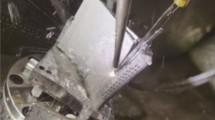Abstract
It is important to predict the groove sidewall penetration for narrow gap MAG welding quality control. In this paper, we present a hybrid model to describe the groove sidewall penetration dynamics. First, sensing system was set up to obtain and fuse the signal from arc sensor, visual sensor, and sidewall penetration sensor. Next, the center position of the rotating arc was varied to generate the experimental data. Due to the fact that sidewall penetration on the left side varies greater than that on the right side, a support vector machine (SVM)-based dynamic model was built to predict the penetration on the left side and a cubic polynomial regression model for the right side. The model developed in this paper can be applied to the further penetration control.
Similar content being viewed by others
References
Wang JY, Ren YS, Yang F, Guo HB (2007) Novel rotation arc system for narrow gap MAG welding. Sci Technol Weld Join 12(6):505–507
Min D, Xin-hua T, Feng-gui L, Shun Y (2011) Welding of quenched and tempered steels with high-spin arc narrow gap MAG system. Int J Adv Manuf Technol 55(5–8):527–533
Yang CL, Guo N, Lin SB, Fan CL, Zhang YQ (2009) Application of rotating arc system to horizontal narrow gap welding. Sci Technol Weld Join 14(2):172–177
Kim GH, Na SJ (2001) A study of an arc sensor model for gas metal arc welding with rotating arc part 1: dynamic simulation of wire melting. Proc Inst Mech Eng B J Eng Manuf 215(9):1271–1279
Bentley AE, Marburger SJ (1992) Arc welding penetration control using quantitative feedback theory. Weld J 71:397–405
Nagesh DS, Datta GL (2002) Prediction of weld bead geometry and penetration in shielded metal-arc welding using artificial neural networks. J Mater Process Technol 123(2):303–312
Chen SB, Zhao DB, Wu L, Lou YJ (2000) Intelligent methodology for sensing, modeling and control of pulsed GTAW: part 2–Butt joint welding. Weld J (USA) 79(6):164–174
Fan C, Lv F, Chen S (2009) Visual sensing and penetration control in aluminum alloy pulsed GTA welding. Int J Adv Manuf Technol 42(1–2):126–137
Kim I, Basu A, Siores E (1996) Mathematical models for control of weld bead penetration in the GMAW process. Int J Adv Manuf Technol 12(6):393–401
Lv N, Zhong J, Chen H, Lin T, Chen S (2014) Real-time control of welding penetration during robotic GTAW dynamical process by audio sensing of arc length. Int J Adv Manuf Technol 74:235–249
Guo N, Lin SB, Zhang L, Yang CL (2009) Metal transfer characteristics of rotating arc narrow gap horizontal GMAW. Sci Technol Weld Join 14(8):760–764
Cortes C, Vapnik V (1995) Support vector machine. Mach Learn 20(3):273–297
Lela B, Bajić D, Jozić S (2009) Regression analysis, support vector machines, and Bayesian neural network approaches to modeling surface roughness in face milling. Int J Adv Manuf Technol 42(11–12):1082–1088
Ye Z, Fang G, Chen S, Zou JJ (2013) Passive vision based seam tracking system for pulse-MAG welding. Int J Adv Manuf Technol 67(9–12):1987–1996
Huang X, Gu W, Shi F, Chen S (2009) An adaptive inverse control method based on SVM-Fuzzy rules acquisition system for pulsed GTAW process. Int J Adv Manuf Technol 44(7–8):686–694
Li W, Gao K, Wu J, Hu T, Wang J (2014) SVM-based information fusion for weld deviation extraction and weld groove state identification in rotating arc narrow gap MAG welding. Int J Adv Manuf Technol 74(9–12):1355–1364
Zhao C, Zhang H, Zhang X, Zhang R, Luan F, Liu M, Hu Z, Fan B (2006) Prediction of milk/plasma drug concentration (M/P) ratio using support vector machine (SVM) method. Pharm Res 23(1):41–48
Author information
Authors and Affiliations
Corresponding author
Rights and permissions
About this article
Cite this article
Li, W., Gao, K., Wu, J. et al. Groove sidewall penetration modeling for rotating arc narrow gap MAG welding. Int J Adv Manuf Technol 78, 573–581 (2015). https://doi.org/10.1007/s00170-014-6678-6
Received:
Accepted:
Published:
Issue Date:
DOI: https://doi.org/10.1007/s00170-014-6678-6




